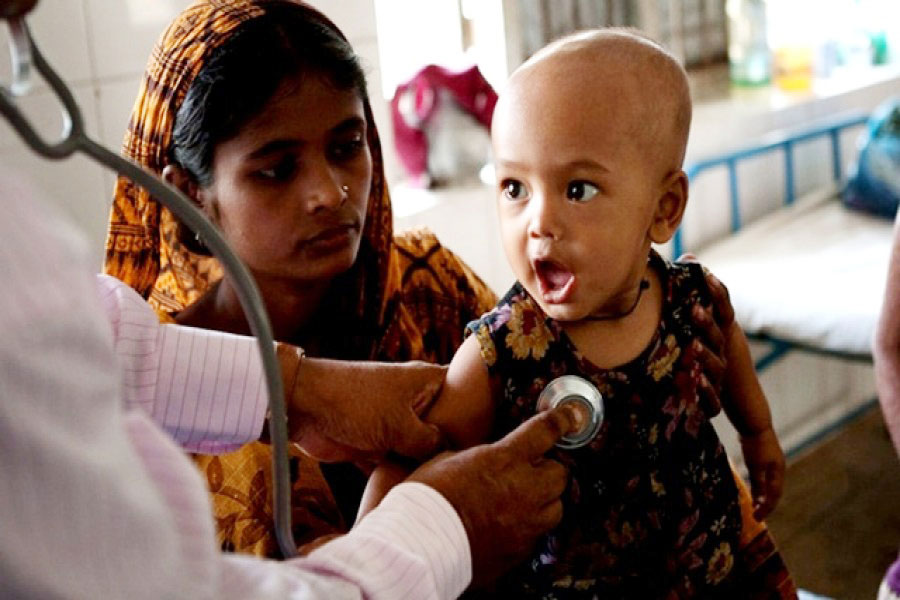
Published :
Updated :

A host of factors determines our health. For making health policy, and developing and delivering health programmes, it is very important to know what these determinants are, how these influence health, and then develop a useful framework to understand it. Bangladesh has been building facilities extensively as developing physical infrastructure has been its primary agenda and focus to improve population health. However, conceptualising the broader concept of health and understanding all influencing factors of health appears to be generally missing in Bangladesh.
If we look around us, our family, friends, and other people in the community, what
becomes obvious is that health is quite variable; it just does not only vary between individuals but also across different population groups within the same society or a region. Why?
If we look at the life expectancy of a child born in Japan today, he/she will live to be 84.26 years old on average while if born in Canada, he/she will live to be 82.24 years. For Bangladesh, it is 74.25 years on average and for Somalia, it is only 56.47 years. The difference in life expectancy between Somalia and Japan is about 28 years.
There are differences in life expectancy even within regions and countries. For example, the life expectancy of native people is about 10 years lower than that of non-indigenous people in Australia. For Bangladesh, it also varies; if we had good data we could show how this varies by region and ethnic monitories.
Social class influences health; people with higher income, greater educational attainment, and holding a safer and high-paying occupation have better health and a higher life expectancy. For example, studies of migrants have shown that the type of diseases, health behaviours, and risk factors are different in migrants in their host country compared to those in their country of origin. For example, the Rohingya in Myanmar and the Rohingya in Bangladesh will be different with respect to their disease profile and burden, health behaviours, and other risk factors. Key health indicators like maternal mortality and child mortality among them will vary between Bangladesh and Myanmar.
Why is there so much variability? We must understand the determinants better that influence health.
A range of factors called determinants of health influences an individual's health. These include individual factors such as age, sex, and genetic makeup. This also includes their health behaviours such as physical activity, alcohol use, smoking, sleep pattern, and diet. Health is largely influenced by the conditions in which people are born and they grow, live, play, work, and age. Determinants also include their social and community networks. The socioeconomic, cultural, and environmental conditions where people live strongly influence their health status. In addition, the health care systems of the country-- how health care services are planned, developed, delivered, and monitored shape the health status of the population. All these are collectively called the social determinants of Health.
The social determinants of health are shaped by the distribution of money, power, and resources at the international, national, and local levels; they create health equities and inequities.
The social determinants of health work across many levels, and there are complex interactions between them. To understand and explain how these determinants influence and interact with each other to affect the health and well-being of the people, several models or frameworks have been proposed. The World Health Organisation (WHO) developed one.
According to the WHO framework, there are two broad types of health determinants that influence health; these are structural determinants and intermediaries. Structural determinants refer to the socio-economic and political context in which an individual is born and lives. These include how society organises itself to make and implement economic, social, and public policies. In addition, social and cultural values vary by community. These factors determine and lead to the unequal distribution of resources which shape a person's socioeconomic standing. A person's place in society affects the exposure, vulnerability, and outcomes to conditions that determine their health. A number of factors such as education, occupation, income, gender or ethnicity, and social class determine someone's socio-economic position.
The socio-economic position then affects the intermediary determinants of health and these include quality of housing and neighbourhood, financial ability to buy healthy and fresh food and groceries, clothing, or other requirements for healthy living. Stressful living and behavioural circumstances also affect health.
In addition to these, the healthcare system has an impact on the type and quality of healthcare services available to people. It determines how easy it is for people to access and receive the health care they need. Social cohesion and social capital are factors that describe the readiness of people in a community to cooperate with each other for a bigger or greater benefit.
The links between these different determinants are not always linear but are complex and can go in both directions. For example, income and education can affect health, and a person with poor health has limited opportunities to participate in the labour force or receive a good education.
Addressing the social determinants involves identifying the structural and intermediate determinants of health and taking appropriate actions to improve them. This requires actions across all sectors of society and at all levels, including local, national, and international. The actions depend on the existing socio-economic and political context, resources that are available, and a commitment to action. Bangladesh needs to go beyond training healthcare workers, building hospitals, and buying machines to improve the population's health.
Hasnat M Alamgir is a Professor and Head of Public Health at the State University of Bangladesh
hasnat.md.alamgir@gmail.com


 For all latest news, follow The Financial Express Google News channel.
For all latest news, follow The Financial Express Google News channel.